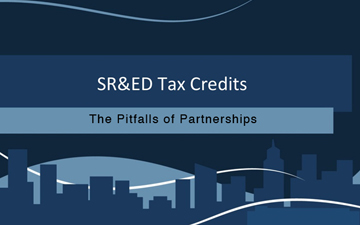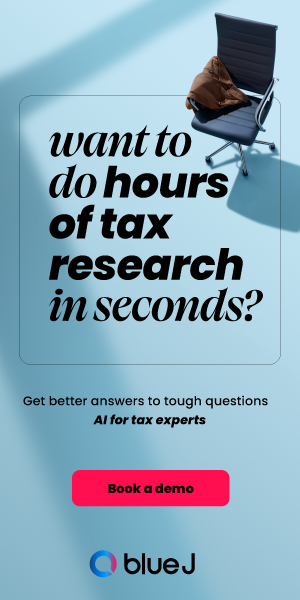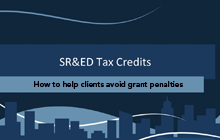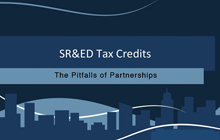Avoiding the pitfalls of partnerships when making SR&ED claims

Partnerships participating in the SR&ED program may find the process to be significantly more complex compared with normal corporations
 |
Richard Hoy is president of specialist tax consultancy Catax Canada. |
Companies of all kinds can claim research and development tax incentives but it’s not just what you’ve been doing that counts — who you’ve been doing it with matters too.
One of the key obstacles accountants need to be aware of is the impact that partnerships can have on claims.
Businesses that are legally structured as partnerships are not excluded from being able to claim SR&ED Investment Tax Credits (ITCs). However, partnerships participating in the SR&ED program may find the process to be significantly more complex compared with normal corporations. Key differences in the treatment of partnership entities may result in reduced benefits. It is vital to consider these prior to making a claim for SR&ED expenditures and credits.
Being aware of these can give accountants the opportunity to help clients ensure they enjoy the maximum benefit possible. Client companies may even take a different approach to how they enter partnerships once they realise the significance of different partnership structures.
Partnerships and SR&ED
At first glance, the rules around partnerships are not easy to fathom. That’s because the Income Tax Act does not define a partnership, it simply outlines the tax consequences if a partnership exists.
The important thing for accountants is that, for tax purposes, a partnership does not have a separate existence from its partners. As a result, a partnership does not file an income tax return, and the income is not taxed at the partnership level.
Since a partnership is not a taxpayer, it cannot earn ITCs either. As a result, any ITCs are calculated at the partnership level but then divided among some or all of the partners, who may be individuals, corporations or trusts.
The key difference for partnerships is that SR&ED is less generous, and is capped at 15% of qualifying expenditure, even if the partner is a Canadian-controlled private corporation or a qualifying corporation. Crucially, this reduced ITC rate of 15% is also only partially refundable; where a partnership has no tax owing in the year, only 40% of the 15% total ITC may be refunded.
The main task facing any members of a partnership is to work out what their share of the ITC is. It must be ‘reasonable’ and generally mirrors their share of the partnership’s income or loss, as agreed by the members.
Eligibility rules also govern which ‘partners’ are entitled to receive a share of any ITCs, within a partnership with several members. ‘Specified members’ are not eligible. These are partners who, during a given tax year or fiscal period, fail any of these three tests:
- been a ‘limited partner’ at any point
- not been substantially involved in the activities of the partnership continuously throughout the year (financing alone is not sufficient)
- not been carrying on a similar business to that of the partnership
A ‘limited partnership’ has at least one general partner and one or more limited partners, who typically invest or contribute assets to the partnership but do not participate in the management of the partnership business. A ‘general partnership’ is composed of two or more general partners, and is often just referred to as a partnership.
To be considered actively engaged in the activities of a partnership, a member would normally be expected to contribute time, labour and attention to the partnership business to an extent which has a meaningful impact on its successful operation. A partner that does not participate at all in the management of the business would certainly not be considered actively engaged.
Where there is a specified member, any ITC that would have gone to them is shared out among the other partners but not necessarily along the same lines. The partners can decide what is reasonable in the circumstances, and take into account investments made by different partners, as well as the debt obligations of the partnership and individual members.
What might this look like in practice?
Example: A partnership consisting of three members, who are individuals, submit a claim for SR&ED expenditures and ITCs. They include an active general partner, a specified member who is not a limited partner (a passive general partner), and a specified member, who is a limited partner (and by definition a specified member).
Each partner contributes $30,000 to the partnership, and the partnership borrows $20,000 from the bank, creating $110,000 in available funds. The partnership agreement says that the members share in the profits (and losses) in proportion to their capital contributions (a third each). The partnership spends $30,000 on qualifying SR&ED costs, creating ITCs of $4,500 ($30,000 x 15%). Based on their partnership agreement, each partner would be allocated a third of the $4,500 ITCs. However, the Act prevents allocating ITCs to specified members, of which it has two.
The allocation would be $1,500 ITCs for the active general partner and $0 for the two specified members, leaving $3,000 of ITCs unallocated. In this example, there is only one non-specified member of the partnership, and this active general partner would therefore receive all the partnership ITCs available.
Companies belonging to partnerships that are performing SR&ED should review their status and involvement annually in light of these rules. The need to do so will be particularly acute for members who, despite investing significant time and money in a partnership, find they still can’t claim SR&ED ITCs because they are classed as ‘specified members’.
Richard Hoy is president of specialist tax consultancy Catax Canada. You can reach him at richard.hoy@catax.com.











(0) Comments